Association of an intensive lifestyle intervention with remission of type 2 diabetes
- PMID: 23288372
- PMCID: PMC4771522
- DOI: 10.1001/jama.2012.67929
Association of an intensive lifestyle intervention with remission of type 2 diabetes
Abstract
Context: The frequency of remission of type 2 diabetes achievable with lifestyle intervention is unclear.
Objective: To examine the association of a long-term intensive weight-loss intervention with the frequency of remission from type 2 diabetes to prediabetes or normoglycemia.
Design, setting, and participants: Ancillary observational analysis of a 4-year randomized controlled trial (baseline visit, August 2001-April 2004; last follow-up, April 2008) comparing an intensive lifestyle intervention (ILI) with a diabetes support and education control condition (DSE) among 4503 US adults with body mass index of 25 or higher and type 2 diabetes.
Interventions: Participants were randomly assigned to receive the ILI, which included weekly group and individual counseling in the first 6 months followed by 3 sessions per month for the second 6 months and twice-monthly contact and regular refresher group series and campaigns in years 2 to 4 (n=2241) or the DSE, which was an offer of 3 group sessions per year on diet, physical activity, and social support (n=2262).
Main outcome measures: Partial or complete remission of diabetes, defined as transition from meeting diabetes criteria to a prediabetes or nondiabetic level of glycemia (fasting plasma glucose <126 mg/dL and hemoglobin A1c <6.5% with no antihyperglycemic medication). RESULTS Intensive lifestyle intervention participants lost significantly more weight than DSE participants at year 1 (net difference, -7.9%; 95% CI, -8.3% to -7.6%) and at year 4 (-3.9%; 95% CI, -4.4% to -3.5%) and had greater fitness increases at year 1 (net difference, 15.4%; 95% CI, 13.7%-17.0%) and at year 4 (6.4%; 95% CI, 4.7%-8.1%) (P < .001 for each). The ILI group was significantly more likely to experience any remission (partial or complete), with prevalences of 11.5% (95% CI, 10.1%-12.8%) during the first year and 7.3% (95% CI, 6.2%-8.4%) at year 4, compared with 2.0% for the DSE group at both time points (95% CIs, 1.4%-2.6% at year 1 and 1.5%-2.7% at year 4) (P < .001 for each). Among ILI participants, 9.2% (95% CI, 7.9%-10.4%), 6.4% (95% CI, 5.3%-7.4%), and 3.5% (95% CI, 2.7%-4.3%) had continuous, sustained remission for at least 2, at least 3, and 4 years, respectively, compared with less than 2% of DSE participants (1.7% [95% CI, 1.2%-2.3%] for at least 2 years; 1.3% [95% CI, 0.8%-1.7%] for at least 3 years; and 0.5% [95% CI, 0.2%-0.8%] for 4 years).
Conclusions: In these exploratory analyses of overweight adults, an intensive lifestyle intervention was associated with a greater likelihood of partial remission of type 2 diabetes compared with diabetes support and education. However, the absolute remission rates were modest. TRIAL REGISTRATION clinicaltrials.gov Identifier: NCT00017953.
Conflict of interest statement
All authors have completed and submitted the ICMJE Form for Disclosure of Potential Conflicts of Interest. Dr Delehanty reported board membership with Eli Lilly, Boeringer Ingelheim, and Johnson and Johnson and consultancy support from Pfizer. Dr Safford reported receiving consultancy support from diaDexus. No other disclosures were reported.
Figures



Comment in
-
A look ahead at the future of diabetes prevention and treatment.JAMA. 2012 Dec 19;308(23):2517-8. doi: 10.1001/jama.2012.144749. JAMA. 2012. PMID: 23287825 No abstract available.
-
[Lifestyle intervention in type 2 diabetes: is remission possible? Overcoming thinking barriers--lifestyle interventions have great benefits!].Dtsch Med Wochenschr. 2013 Mar;138(11):514. doi: 10.1055/s-0032-1329039. Epub 2013 Mar 5. Dtsch Med Wochenschr. 2013. PMID: 23463470 German. No abstract available.
-
ACP Journal Club. An intensive lifestyle intervention increased remission from type 2 diabetes in overweight adults.Ann Intern Med. 2013 May 21;158(10):JC4. doi: 10.7326/0003-4819-158-10-201305210-02004. Ann Intern Med. 2013. PMID: 23689783 No abstract available.
Similar articles
-
Long-term effects of a lifestyle intervention on weight and cardiovascular risk factors in individuals with type 2 diabetes mellitus: four-year results of the Look AHEAD trial.Arch Intern Med. 2010 Sep 27;170(17):1566-75. doi: 10.1001/archinternmed.2010.334. Arch Intern Med. 2010. PMID: 20876408 Free PMC article. Clinical Trial.
-
Effect of a lifestyle intervention on change in cardiorespiratory fitness in adults with type 2 diabetes: results from the Look AHEAD Study.Int J Obes (Lond). 2009 Mar;33(3):305-16. doi: 10.1038/ijo.2008.280. Epub 2009 Jan 20. Int J Obes (Lond). 2009. PMID: 19153582 Free PMC article. Clinical Trial.
-
Effect of an Intensive Lifestyle Intervention on Glycemic Control in Patients With Type 2 Diabetes: A Randomized Clinical Trial.JAMA. 2017 Aug 15;318(7):637-646. doi: 10.1001/jama.2017.10169. JAMA. 2017. PMID: 28810024 Free PMC article. Clinical Trial.
-
Behavioral Counseling to Promote a Healthful Diet and Physical Activity for Cardiovascular Disease Prevention in Adults Without Known Cardiovascular Disease Risk Factors: Updated Systematic Review for the U.S. Preventive Services Task Force [Internet].Rockville (MD): Agency for Healthcare Research and Quality (US); 2017 Jul. Report No.: 15-05222-EF-1. Rockville (MD): Agency for Healthcare Research and Quality (US); 2017 Jul. Report No.: 15-05222-EF-1. PMID: 29364620 Free Books & Documents. Review.
-
Folic acid supplementation and malaria susceptibility and severity among people taking antifolate antimalarial drugs in endemic areas.Cochrane Database Syst Rev. 2022 Feb 1;2(2022):CD014217. doi: 10.1002/14651858.CD014217. Cochrane Database Syst Rev. 2022. PMID: 36321557 Free PMC article.
Cited by
-
Association of visit-to-visit variability of hemoglobin A1c and medication adherence.J Manag Care Spec Pharm. 2015 Mar;21(3):229-37. doi: 10.18553/jmcp.2015.21.3.229. J Manag Care Spec Pharm. 2015. PMID: 25726032 Free PMC article.
-
George A. Bray, MD: Progress in Obesity-Multidisciplinary Research, Multidimensional Man.Diabetes Care. 2016 Sep;39(9):1481-5. doi: 10.2337/dc16-1375. Diabetes Care. 2016. PMID: 27555621 Free PMC article. No abstract available.
-
Clinical Update: Cardiovascular Disease in Diabetes Mellitus: Atherosclerotic Cardiovascular Disease and Heart Failure in Type 2 Diabetes Mellitus - Mechanisms, Management, and Clinical Considerations.Circulation. 2016 Jun 14;133(24):2459-502. doi: 10.1161/CIRCULATIONAHA.116.022194. Circulation. 2016. PMID: 27297342 Free PMC article. Review.
-
Weight Change During the Postintervention Follow-up of Look AHEAD.Diabetes Care. 2022 Apr 14;45(6):1306-14. doi: 10.2337/dc21-1990. Online ahead of print. Diabetes Care. 2022. PMID: 35421225 Free PMC article.
-
Embracing complexity: making sense of diet, nutrition, obesity and type 2 diabetes.Diabetologia. 2023 May;66(5):786-799. doi: 10.1007/s00125-023-05873-z. Epub 2023 Feb 14. Diabetologia. 2023. PMID: 36786838 Free PMC article. Review.
References
-
- Nathan DM. Long-term complications of diabetes mellitus. N Engl J Med. 1993;328(23):1676–1685. - PubMed
-
- Kahn SE, Hull RL, Utzschneider KM. Mechanisms linking obesity to insulin resistance and type 2 diabetes. Nature. 2006;444(7121):840–846. - PubMed
-
- Centers for Disease Control and Prevention. National Diabetes Fact Sheet: National Estimates and General Information on Diabetes and Prediabetes in the United States. Atlanta, GA: Centers for Control and Prevention; 2011.
-
- Buchwald H, Estok R, Fahrbach K, et al. Weight and type 2 diabetes after bariatric surgery: systematic review and meta-analysis. Am J Med. 2009;122(3):248–256. e5. - PubMed
Publication types
MeSH terms
Substances
Associated data
Grants and funding
- DK57078/DK/NIDDK NIH HHS/United States
- DK57151/DK/NIDDK NIH HHS/United States
- U01 DK057154/DK/NIDDK NIH HHS/United States
- U01 DK057171/DK/NIDDK NIH HHS/United States
- U01 DK057182/DK/NIDDK NIH HHS/United States
- U01 DK057136/DK/NIDDK NIH HHS/United States
- U01 DK057002/DK/NIDDK NIH HHS/United States
- U01 DK057177/DK/NIDDK NIH HHS/United States
- M01 RR001066/RR/NCRR NIH HHS/United States
- U01 DK057078/DK/NIDDK NIH HHS/United States
- DK57008/DK/NIDDK NIH HHS/United States
- M01RR000056/RR/NCRR NIH HHS/United States
- DK57135/DK/NIDDK NIH HHS/United States
- K24 DK062222/DK/NIDDK NIH HHS/United States
- UL1 RR 024153/RR/NCRR NIH HHS/United States
- R01 DK048117/DK/NIDDK NIH HHS/United States
- U01 DK057151/DK/NIDDK NIH HHS/United States
- P30 DK048520/DK/NIDDK NIH HHS/United States
- U01 DK057135/DK/NIDDK NIH HHS/United States
- UL1 RR024153/RR/NCRR NIH HHS/United States
- P30 DK046204/DK/NIDDK NIH HHS/United States
- DK57171/DK/NIDDK NIH HHS/United States
- M01 RR002719/RR/NCRR NIH HHS/United States
- DK57131/DK/NIDDK NIH HHS/United States
- M01 RR000056/RR/NCRR NIH HHS/United States
- U01 DK057219/DK/NIDDK NIH HHS/United States
- DK57149/DK/NIDDK NIH HHS/United States
- U01 DK056992/DK/NIDDK NIH HHS/United States
- M01RR01066/RR/NCRR NIH HHS/United States
- R01 DK060427/DK/NIDDK NIH HHS/United States
- DK57182/DK/NIDDK NIH HHS/United States
- DK57002/DK/NIDDK NIH HHS/United States
- M01RR01346/RR/NCRR NIH HHS/United States
- DK57178/DK/NIDDK NIH HHS/United States
- P30 DK48520/DK/NIDDK NIH HHS/United States
- U01 DK057131/DK/NIDDK NIH HHS/United States
- M01 RR000051/RR/NCRR NIH HHS/United States
- ImNIH/Intramural NIH HHS/United States
- DK57136/DK/NIDDK NIH HHS/United States
- DK57154/DK/NIDDK NIH HHS/United States
- DK57219/DK/NIDDK NIH HHS/United States
- R01 DK089557/DK/NIDDK NIH HHS/United States
- DK57177/DK/NIDDK NIH HHS/United States
- R01 DK083393/DK/NIDDK NIH HHS/United States
- U01 DK056990/DK/NIDDK NIH HHS/United States
- U01 DK057178/DK/NIDDK NIH HHS/United States
- U01 DK057008/DK/NIDDK NIH HHS/United States
- DK56990/DK/NIDDK NIH HHS/United States
- CC999999/ImCDC/Intramural CDC HHS/United States
- M01RR0021140/RR/NCRR NIH HHS/United States
- DK 046204/DK/NIDDK NIH HHS/United States
- U01 DK057149/DK/NIDDK NIH HHS/United States
- M01RR02719/RR/NCRR NIH HHS/United States
- M01 RR001346/RR/NCRR NIH HHS/United States
- DK56992/DK/NIDDK NIH HHS/United States
- P30 DK017047/DK/NIDDK NIH HHS/United States
- M01RR00051/RR/NCRR NIH HHS/United States

